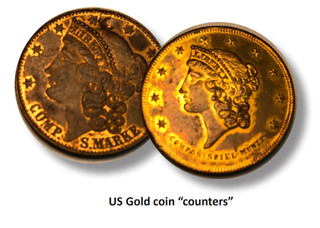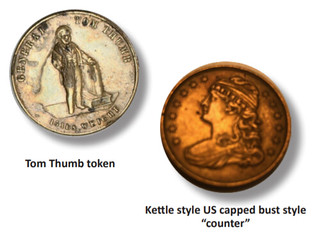
PREV ARTICLE
NEXT ARTICLE
FULL ISSUE
PREV FULL ISSUE
AN ESSAY ON GAMING COUNTERSAnd here's another interesting article inspired by the impressive Ben Fauver collection being auctioned by Holabird Americana: a 16-page essay by Fred Holabird on Gaming Counters. Here's an except - see the complete article online. -Editor
American counters come in many forms from many different die sinkers from several different countries over a wide span in time. Their use was ostensibly for a variety of card games, which may have begun with Whist, a form of Bridge as we know it today. Originally a western European game, it worked its way into America but was never as popular as it was in Europe. Instead, forms of poker took over, still prevalent today. During the course of study of counters, some glaring anomalies arose, true mysteries that became the source of questions and intrigue.
Introduction The result was that Fauver collected thousands of pieces. He became fascinated with the source in antiquity of counters in western Europe and began collecting those too. Over the years, as I became fascinated with these lookalike US gold coins and relics of the California Gold Rush gambling communities, our company(s) began acquiring them, first as a collection, then for resale. At the time, getting counters "slabbed" by third party grading services was almost impossible. While a few were listed in a number of important references such as Russ Rulau's massive token tome, most were unknown to the grading services, who did not have copies of Fauver's catalogs. My attempts at third party grading years ago were futile. We "typed" each piece we sent in, only to have the grading service completely ignore the Fauver "type" and catalog number. Days and weeks of study went completely down the drain. Fauver's guidebooks didn't help – they were privately published in small quantity, difficult to attain, and are complicated with very little discussion about the pieces themselves, something we all like to read and learn about.
The remaining problem is obvious – market. The market for counters needs to be re-established. With the Fauver Collection, there are hundreds of pieces in mint states. Will they withstand the cost of third party grading and certification in the new market? In order to get these out in a timely manner, it became necessary to release them "raw." We have experimented with a number of certified and raw pieces placed into differing forms of numismatic auctions with very mixed results, that when looked upon analytically, make no sense. With this knowledge, we have chosen to "lot" the coins into specific small collections, highlighting several different facets of counters that could attract new and old collectors alike. 
There is much, much more to Fred's great article, so be sure to read it all online. For bibliophiles, here's Fred's list of Fauver's books. -Editor Fauver split counters into categories, choosing to create a number of separate works instead of a single volume. All were privately published and distributed by Fauver. (no number) Exonumia, Symbolism and Classification (1982) Part 1. Eagle and Double Eagle Gold (1983) Part 2. Half Eagle Gold (1989) Part 3. Three Dollar and Quarter Eagle Gold (1989) Part 4. One Dollar Gold and One Dollar Silver (1990) Part 5. Minor Denominations and Miscellany (1990) Part 6. Latin America and Canada (1990) (No number) A trial Listing of Recmenmeister/ A B C Counters of the 1500s (1990) (no number) Early California Counters (1991)
To read the complete article, see:

Wayne Homren, Editor The Numismatic Bibliomania Society is a non-profit organization promoting numismatic literature. See our web site at coinbooks.org. To submit items for publication in The E-Sylum, write to the Editor at this address: whomren@gmail.com To subscribe go to: https://my.binhost.com/lists/listinfo/esylum All Rights Reserved. NBS Home Page Contact the NBS webmaster 
|


